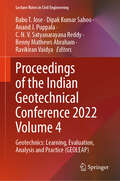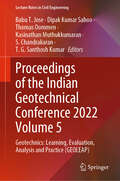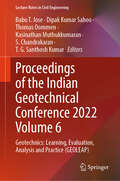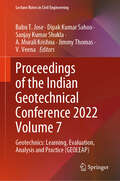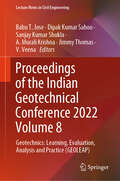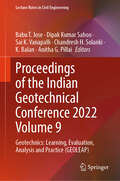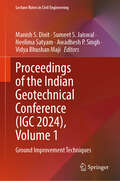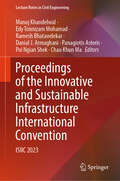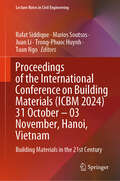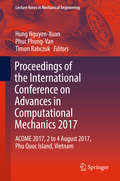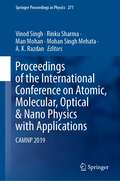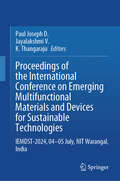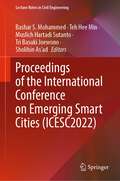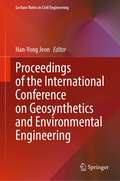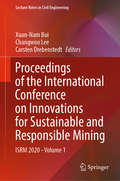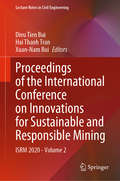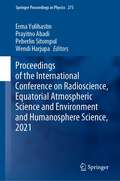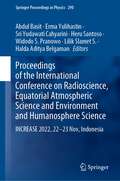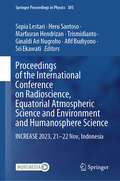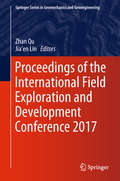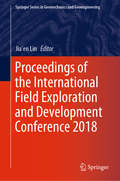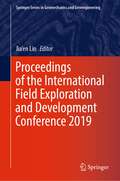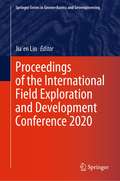- Table View
- List View
Proceedings of the Indian Geotechnical Conference 2022 Volume 3: Geotechnics: Learning, Evaluation, Analysis and Practice (GEOLEAP) (Lecture Notes in Civil Engineering #478)
by C. N. V. Satyanarayana Reddy Ravikiran Vaidya Babu T. Jose Dipak Kumar Sahoo Anand J. Puppala Benny Mathews AbrahamThis book comprises the select proceedings of the Indian Geotechnical Conference (IGC) 2022. The contents focus on recent developments in geotechnical engineering for a sustainable world. The book covers behavior of soils and soil–structure interaction, soil stabilization, ground improvement, and land reclamation, shallow and deep foundations, geotechnical, geological and geophysical investigation, rock engineering, tunneling and underground structures, slope stability, landslides and liquefaction, earth retaining structures and deep excavations, geosynthetics engineering, geo-environmental engineering, sustainable geotechnics, and landfill design, geo-hydrology, dam and embankment engineering, earthquake geotechnical engineering, transportation geotechnics, forensic geotechnical engineering and retrofitting of geotechnical structures, offshore geotechnics, marine geology and sub-sea site investigation, computational, analytical and numerical modeling, and reliability in geotechnical engineering. The contents of this book are useful to researchers and professionals alike.
Proceedings of the Indian Geotechnical Conference 2022 Volume 4: Geotechnics: Learning, Evaluation, Analysis and Practice (GEOLEAP) (Lecture Notes in Civil Engineering #479)
by C. N. V. Satyanarayana Reddy Ravikiran Vaidya Babu T. Jose Dipak Kumar Sahoo Anand J. Puppala Benny Mathews AbrahamThis book comprises the select proceedings of the Indian Geotechnical Conference (IGC) 2022. The contents focus on recent developments in geotechnical engineering for a sustainable world. The book covers behavior of soils and soil–structure interaction, soil stabilization, ground improvement, and land reclamation, shallow and deep foundations, geotechnical, geological and geophysical investigation, rock engineering, tunneling and underground structures, slope stability, landslides and liquefaction, earth retaining structures and deep excavations, geosynthetics engineering, geo-environmental engineering, sustainable geotechnics, and landfill design, geo-hydrology, dam and embankment engineering, earthquake geotechnical engineering, transportation geotechnics, forensic geotechnical engineering and retrofitting of geotechnical structures, offshore geotechnics, marine geology and sub-sea site investigation, computational, analytical and numerical modeling, and reliability in geotechnical engineering. The contents of this book are useful to researchers and professionals alike.
Proceedings of the Indian Geotechnical Conference 2022 Volume 5: Geotechnics: Learning, Evaluation, Analysis and Practice (GEOLEAP) (Lecture Notes in Civil Engineering #483)
by Kasinathan Muthukkumaran Babu T. Jose Dipak Kumar Sahoo Thomas Oommen S. Chandrakaran T. G. Santhosh KumarThis book comprises the select proceedings of the Indian Geotechnical Conference (IGC) 2022. The contents focus on recent developments in geotechnical engineering for a sustainable world. The book covers behavior of soils and soil-structure interaction, soil stabilization, ground improvement, and land reclamation, shallow and deep foundations, geotechnical, geological and geophysical investigation, rock engineering, tunneling, and underground structures, slope stability, landslides and liquefaction, earth retaining structures and deep excavations, geosynthetics engineering, geo-environmental engineering, sustainable geotechnics, and landfill design, geo-hydrology, dam and embankment engineering, earthquake geotechnical engineering, transportation geotechnics, forensic geotechnical engineering and retrofitting of geotechnical structures, offshore geotechnics, marine geology and subsea site investigation, computational, analytical and numerical modeling, and reliability in geotechnical engineering. The contents of this book are useful for researchers and professionals alike.
Proceedings of the Indian Geotechnical Conference 2022 Volume 6: Geotechnics: Learning, Evaluation, Analysis and Practice (GEOLEAP) (Lecture Notes in Civil Engineering #484)
by Kasinathan Muthukkumaran Babu T. Jose Dipak Kumar Sahoo Thomas Oommen S. Chandrakaran T. G. Santhosh KumarThis book comprises the select proceedings of the Indian Geotechnical Conference (IGC) 2022. The contents focus on recent developments in geotechnical engineering for a sustainable world. The book covers behavior of soils and soil-structure interaction, soil stabilization, ground improvement, and land reclamation, shallow and deep foundations, geotechnical, geological and geophysical investigation, rock engineering, tunneling, and underground structures, slope stability, landslides and liquefaction, earth retaining structures and deep excavations, geosynthetics engineering, geo-environmental engineering, sustainable geotechnics, and landfill design, geo-hydrology, dam and embankment engineering, earthquake geotechnical engineering, transportation geotechnics, forensic geotechnical engineering and retrofitting of geotechnical structures, offshore geotechnics, marine geology and subsea site investigation, computational, analytical and numerical modeling, and reliability in geotechnical engineering. The contents of this book are useful for researchers and professionals alike.
Proceedings of the Indian Geotechnical Conference 2022 Volume 7: Geotechnics: Learning, Evaluation, Analysis and Practice (GEOLEAP) (Lecture Notes in Civil Engineering #491)
by Sanjay Kumar Shukla A. Murali Krishna Babu T. Jose Dipak Kumar Sahoo Jimmy Thomas V. VeenaThis book comprises the select proceedings of the Indian Geotechnical Conference (IGC) 2022. The book focuses on recent developments in geotechnical engineering for a sustainable world. The book covers behavior of soils and soil-structure interaction, soil stabilization, ground improvement, and land reclamation, shallow and deep foundations, geotechnical, geological and geophysical investigation, rock engineering, tunneling, and underground structures, slope stability, landslides and liquefaction, earth retaining structures and deep excavations, geosynthetics engineering, geo-environmental engineering, sustainable geotechnics, and landfill design, geo-hydrology, dam and embankment engineering, earthquake geotechnical engineering, transportation geotechnics, forensic geotechnical engineering and retrofitting of geotechnical structures, offshore geotechnics, marine geology and subsea site investigation, computational, analytical and numerical modeling and reliability in geotechnical engineering. The book is useful to researchers and professionals alike.
Proceedings of the Indian Geotechnical Conference 2022 Volume 8: Geotechnics: Learning, Evaluation, Analysis and Practice (GEOLEAP) (Lecture Notes in Civil Engineering #492)
by Sanjay Kumar Shukla A. Murali Krishna Babu T. Jose Dipak Kumar Sahoo Jimmy Thomas V. VeenaThis book comprises the select proceedings of the Indian Geotechnical Conference (IGC) 2022. The book focuses on recent developments in geotechnical engineering for a sustainable world. The book covers behavior of soils and soil-structure interaction, soil stabilization, ground improvement, and land reclamation, shallow and deep foundations, geotechnical, geological and geophysical investigation, rock engineering, tunneling, and underground structures, slope stability, landslides and liquefaction, earth retaining structures and deep excavations, geosynthetics engineering, geo-environmental engineering, sustainable geotechnics, and landfill design, geo-hydrology, dam and embankment engineering, earthquake geotechnical engineering, transportation geotechnics, forensic geotechnical engineering and retrofitting of geotechnical structures, offshore geotechnics, marine geology and subsea site investigation, computational, analytical and numerical modeling and reliability in geotechnical engineering. The book is useful to researchers and professionals alike.
Proceedings of the Indian Geotechnical Conference 2022 Volume 9: Geotechnics: Learning, Evaluation, Analysis and Practice (GEOLEAP) (Lecture Notes in Civil Engineering #537)
by Babu T. Jose Dipak Kumar Sahoo Sai K. Vanapalli Chandresh H. Solanki K. Balan Anitha G. PillaiThis book comprises the select proceedings of the Indian Geotechnical Conference (IGC) 2022. The contents focus on recent developments in geotechnical engineering for a sustainable world. The book covers behaviour of soils and soil–structure interaction, soil stabilization, ground improvement, and land reclamation, shallow and deep foundations, geotechnical, geological and geophysical investigation, rock engineering, tunnelling, and underground structures, slope stability, landslides and liquefaction, earth retaining structures and deep Excavations, geosynthetics engineering, geo-environmental engineering, sustainable geotechnics, and landfill design, geo-hydrology, dam and embankment engineering, earthquake geotechnical engineering, transportation geotechnics, forensic geotechnical engineering and retrofitting of geotechnical structures, offshore geotechnics, marine geology, and subsea site investigation, computational, analytical and numerical modelling, and reliability in geotechnical engineering. The contents of this book will be useful to researchers and professionals alike.
Proceedings of the Indian Geotechnical Conference: Ground Improvement Techniques (Lecture Notes in Civil Engineering #626)
by Neelima Satyam Manish S. Dixit Vidya Bhushan Maji Sumeet S. Jaiswal Awadhesh P. SinghThis book presents select proceedings of the Indian Geotechnical Conference (IGC) 2024 held at MIT, Chhatrapati Sambhajinagar. The book provides the collection of papers that were presented at the IGC 2024. The book covers topic related to geophysical investigation, shallow and deep foundation, geosynthetics, earth retaining structures, soil dynamics, ground improvement, physical and numerical modelling, tunnelling and underground structures, reliability in geotechnical engineering, geomaterial characterisation and so on. This book provides its readers an opportunity to enhance their research capacities and knowledge in the various fields of geotechnical engineering. This book is a valuable reference book for beginners, researchers, academician and professionals interested in geotechnical engineering covering the design and execution of foundations and other structures for variety of infrastructural projects.
Proceedings of the Innovative and Sustainable Infrastructure International Convention: ISIIC 2023 (Lecture Notes in Civil Engineering #632)
by Edy Tonnizam Mohamad Manoj Khandelwal Ramesh Bhatawdekar Danial J. Armaghani Panagiotis Asteris Poi Ngian Shek Chau Khun MaThis book presents selected papers from the Proceedings of the International Conference on Innovative Infrastructures, ICII 2023, held in Kuala Lumpur, Malaysia, covering topic areas in mining geomechanics, ground control, engineering geology, geohazards, soft computing, and underground structures. The published articles cover the latest research studies in geotechnical and geoengineering with the focus of soft computing technology to solve complex geotechnical issues in mining, tunneling, and geotechnical structures. It also highlights state-of-the-art technologies adopted by the civil, geology, and mining industries which are not only commercially viable but also environmentally sustainable. The content of the papers appeals to researchers and industrial practitioners working in the field of geomechanics and geoengineering.
Proceedings of the International Conference on Building Materials: Building Materials in the 21st Century (Lecture Notes in Civil Engineering #585)
by Juan Li Rafat Siddique Marios Soutsos Trong-Phuoc Huynh Tuan NgoThis volume presents articles from the International Conference on Building Materials; ICBM2024 with the theme “Building Materials in the 21st Century”, held at Hanoi in Vietnam, from 31st October to 03rd November. The conference is a diversified-topic forum for international and Vietnamese researchers, academics, industry professionals, experts and policy makers etc. to share their views, and to learn from others about recent and current developments in science and technology of building materials in the 21st century and also to discuss actions required for forthcoming building materials as well as construction development in the future. The book highlights recent research on cement, concrete, refractory materials, fire-resistant materials, paints, glass, product quality testing methods, environmental protection and recycling wastes in building material industry.
Proceedings of the International Conference on Advances in Computational Mechanics 2017: Acome 2017, 2 To 4 August 2017, Phu Quoc Island, Vietnam (Lecture Notes In Mechanical Engineering)
by Hung Nguyen-Xuan Phuc Phung-Van Timon RabczukThis book provides an overview of state-of-the-art methods in computational engineering for modeling and simulation.This proceedings volume includes a selection of refereed papers presented at the International Conference on Advances in Computational Mechanics (ACOME) 2017, which took place on Phu Quoc Island, Vietnam on August 2-4, 2017.The contributions highlight recent advances in and innovative applications of computational mechanics. Subjects covered include: biological systems; damage, fracture and failure; flow problems; multiscale multiphysics problems; composites and hybrid structures; optimization and inverse problems; lightweight structures; computational mechatronics; computational dynamics; numerical methods; and high-performance computing.The book is intended for academics, including graduate students and experienced researchers interested in state-of-the-art computational methods for solving challenging problems in engineering.
Proceedings of the International Conference on Atomic, Molecular, Optical & Nano Physics with Applications: CAMNP 2019 (Springer Proceedings in Physics #271)
by Man Mohan Vinod Singh Rinku Sharma Mohan Singh Mehata A. K. RazdanThis book highlights the proceedings of the International Conference on Atomic, Molecular, Optical and Nano-Physics with Applications (CAMNP 2019), organized by the Department of Applied Physics, Delhi Technological University, New Delhi, India. It presents experimental and theoretical studies of atoms, ions, molecules and nanostructures both at the fundamental level and on the application side using advanced technology. It highlights how modern tools of high-field and ultra-fast physics are no longer merely used to observe nature but can be used to reshape and redirect atoms, molecules, particles or radiation. It brings together leading researchers and professionals on the field to present and discuss the latest finding in the following areas, but not limited to: Atomic and Molecular Structure, Collision Processes, Data Production and Applications Spectroscopy of Solar and Stellar Plasma Intense Field, Short Pulse Laser and Atto-Second Physics Laser Technology, Quantum Optics and applications Bose Einstein condensation Nanomaterials and Nanoscience Nanobiotechnolgy and Nanophotonics Nano and Micro-Electronics Computational Condensed Matter Physics
Proceedings of the International Conference on Earthquake Engineering and Structural Dynamics (Geotechnical, Geological and Earthquake Engineering #47)
by Rajesh Rupakhety Simon Olafsson Bjarni BessasonThis book includes a collection of chapters that were presented at the International Conference on Earthquake Engineering and Structural Dynamics (ICESD), held in Reykjavik, Iceland between 12-14 June 2017. The contributions address a wide spectrum of subjects related to wind engineering, earthquake engineering, and structural dynamics. Dynamic behavior of ultra long span bridges that are discussed in this volume represent one of the most challenging and ambitious contemporary engineering projects. Concepts, principles, and applications of earthquake engineering are presented in chapters addressing various aspects such as ground motion modelling, hazard analysis, structural analysis and identification, design and detailing of structures, risk due to non-structural components, and risk communication and mitigation. The presented chapters represent the state-of-the-art in these fields as well as the most recent developments.
Proceedings of the International Conference on Emerging Multifunctional Materials and Devices for Sustainable Technologies: IEMDST-2024, 04-05 July, NIT Warangal, India
by Paul Joseph D. Jayalakshmi V. K. ThangarajuThis book includes peer reviewed articles from IEMDST-2024, held on 04-05 July at NIT Warangal in India. The motivation behind the International Conference on Emerging Multifunctional Materials and Devices for Sustainable Technologies (IEMDST-2024) is to address and highlight the critical role of advanced materials and devices in the pursuit of sustainable technologies. The conference is organized by the Department of Physics at the National Institute of Technology, Warangal, in collaboration with the Department of Applied Sciences of NIT Goa. It serves as a catalyst for the exchange of knowledge and ideas among researchers and professionals from various fields related to materials science and technology.
Proceedings of the International Conference on Emerging Smart Cities (Lecture Notes in Civil Engineering #324)
by Bashar S. Mohammed Teh Hee Min Muslich Hartadi Sutanto Tri Basuki Joewono Sholihin As’adThis book contains papers presented at the International Conference on Emerging Smart Cities (ICESC2022), previously known as the International Conference on Civil, Offshore and Environmental Engineering (ICCOEE). ICESC is held under the banner of World Engineering, Science and Technology Congress (ESTCON2022) from 1 to2 December 2022 at Borneo Convention Centre, Kuching, Sarawak, Malaysia. This proceeding contains papers presented by academics and industrial practitioners showcasing the latest advancements and findings in civil engineering areas with an emphasis on emerging smart cities for the ultimate shape of urban living in the near future. The papers are categorized under the following tracks: (1) Climate Adaptive materials; (2) Environmental sustainability; (3) Infrastructure efficiency.
Proceedings of the International Conference on Geosynthetics and Environmental Engineering (Lecture Notes in Civil Engineering #374)
by Han-Yong JeonThis book presents selected papers from the Proceedings of the International Conference on Geosynthetics and Environmental Engineering, ICGEE 2023, held in Jeju Island, South Korea, covering topic areas in geosynthetic applications and sustainability; civil and structural engineering; and environmental engineering and science. The published articles cover the latest research studies with the focus of discussing the relationship between geotechnical materials and environmental engineering in depth to solve complex geosynthetics issues in civil and environmental engineering. It also highlights state-of-the-art technologies adopted by the relevant industries which are not only commercially viable but also environmentally sustainable. The content of the papers appeals to researchers and industrial practitioners working in the field of geoengineering.
Proceedings of the International Conference on Innovations for Sustainable and Responsible Mining: ISRM 2020 - Volume 1 (Lecture Notes in Civil Engineering #109)
by Carsten Drebenstedt Xuan-Nam Bui Changwoo LeeThis volume gathers the latest advances, innovations, and applications in the field of mining, geology and geo-spatial technologies, as presented by leading researchers and engineers at the International Conference on Innovations for Sustainable and Responsible Mining (ISRM), held in Hanoi, Vietnam on October 15-17 2020. The contributions cover a diverse range of topics, including mining technology, drilling and blasting engineering, tunneling and geotechnical applications, mineral processing, mine management and economy, environmental risk assessment and management, mining and local development, mined land rehabilitation, water management and hydrogeology, regional Geology and tectonics, spatial engineering for monitoring natural resources and environment change, GIS and remote sensing for natural disaster monitoring, risk mapping and revisualization, natural resources monitoring and management, mine occupational safety and health. Selected by means of a rigorous peer-review process, they will spur novel research directions and foster future multidisciplinary collaborations.
Proceedings of the International Conference on Innovations for Sustainable and Responsible Mining: ISRM 2020 - Volume 2 (Lecture Notes in Civil Engineering #108)
by Dieu Tien Bui Hai Thanh Tran Xuan-Nam BuiThis volume gathers the latest advances, innovations, and applications in the field of mining, geology and geo-spatial technologies, as presented by leading researchers and engineers at the International Conference on Innovations for Sustainable and Responsible Mining (ISRM), held in Hanoi, Vietnam on October 15-17 2020. The contributions cover a diverse range of topics, including mining technology, drilling and blasting engineering, tunneling and geotechnical applications, mineral processing, mine management and economy, environmental risk assessment and management, mining and local development, mined land rehabilitation, water management and hydrogeology, regional Geology and tectonics, spatial engineering for monitoring natural resources and environment change, GIS and remote sensing for natural disaster monitoring, risk mapping and revisualization, natural resources monitoring and management, mine occupational safety and health. Selected by means of a rigorous peer-review process, they will spur novel research directions and foster future multidisciplinary collaborations.
Proceedings of the International Conference on Radioscience, Equatorial Atmospheric Science and Environment and Humanosphere Science, 2021 (Springer Proceedings in Physics #275)
by Erma Yulihastin Prayitno Abadi Peberlin Sitompul Wendi HarjupaThis book presents recent advances in the area of Radioscience, Equatorial Atmospheric Science and Environment from the international symposium for equatorial atmosphere of the celebration of the Equatorial Atmosphere Radar (EAR) 20th Anniversary, conducted by Indonesian National Institute of Aeronautics and Space (LAPAN) and Kyoto University, in 2021. It provides a scientific platform for all participants to discuss ideas and current issues as well as to design solutions in the areas of atmospheric science, environmental science, space science, and related fields.
Proceedings of the International Conference on Radioscience, Equatorial Atmospheric Science and Environment and Humanosphere Science: INCREASE 2022, 22-23 Nov, Indonesia (Springer Proceedings in Physics #290)
by Erma Yulihastin Abdul Basit Sri Yudawati Cahyarini Heru Santoso Widodo S. Pranowo Lilik Slamet S. Halda Aditya BelgamanThis book highlights latest research advance in the field of Radioscience, Equatorial Atmospheric Science and Environment as part of the International Symposium for Equatorial Atmosphere celebrating the 21st Anniversary of the Equatorial Atmosphere Radar (EAR) , organized by Research Center for Climate and Atmosphere (PRIMA) of National Research and Innovation Agency (BRIN). The symposium provides a scientific platform for researchers and professionals to discuss ideas and current issues as well as to design the solutions in the areas of space science, ocean science, atmospheric science, , environmental science, material science, and other related disciplines.
Proceedings of the International Conference on Radioscience, Equatorial Atmospheric Science and Environment and Humanosphere Science: INCREASE 2023, 21–22 Nov, Indonesia (Springer Proceedings in Physics #305)
by Heru Santoso Sopia Lestari Marfasran Hendrizan Trismidianto Ginaldi Ari Nugroho Afif Budiyono Sri EkawatiThis book includes peer-reviewed articles from INCREASE 2023, Indonesia. It highlights research in the field of Radioscience, Equatorial Atmospheric Science and Environment organized by the Research Center for Climate and Atmosphere (PRIMA) of the National Research and Innovation Agency (BRIN). The symposium aims to provide a scientific platform for students, teachers, and researchers to discuss ideas and current issues in the areas of atmosphere and ocean observation, and prediction, climate change, urban climate, and sustainable development, atmospheric chemistry and air quality, atmosphere-ocean interaction and climate variability, atmosphere and space interaction, paleoclimatology, cloud physics and its application, and atmospheric dynamics and hydrometeorology.
Proceedings of the International Field Exploration and Development Conference 2017 (Springer Series in Geomechanics and Geoengineering)
by Zhan Qu Jia'En LinThis book presents selected papers from the 7th International Field Exploration and Development Conference (IFEDC 2017), which focus on upstream technologies used in oil & gas development, the principles of the process, and various design technologies. The conference not only provides a platform for exchanging lessons learned, but also promotes the development of scientific research in oil & gas exploration and production. The book will benefit a broad readership, including industry experts, researchers, educators, senior engineers and managers.
Proceedings of the International Field Exploration and Development Conference 2018 (Springer Series in Geomechanics and Geoengineering)
by Jia’en LinThis book gathers selected papers from the 8th International Field Exploration and Development Conference (IFEDC 2018) and addresses a broad range of topics, including: Reservoir Surveillance and Management, Reservoir Evaluation and Dynamic Description, Reservoir Production Stimulation and EOR, Ultra-Tight Reservoirs, Unconventional Oil and Gas Resources Technology, Oil and Gas Well Production Testing, and Geomechanics. In brief, the papers introduce readers to upstream technologies used in oil & gas development, the main principles of the process, and various related design technologies. The conference not only provided a platform to exchange experiences, but also promoted the advancement of scientific research in oil & gas exploration and production. The book is chiefly intended for industry experts, professors, researchers, senior engineers, and enterprise managers.
Proceedings of the International Field Exploration and Development Conference 2019 (Springer Series in Geomechanics and Geoengineering)
by Jia’en LinThis book gathers selected papers from the 8th International Field Exploration and Development Conference (IFEDC 2019) and addresses a broad range of topics, including: Low Permeability Reservoir, Unconventional Tight & Shale Oil Reservoir, Unconventional Heavy Oil and Coal Bed Gas, Digital and Intelligent Oilfield, Reservoir Dynamic Analysis, Oil and Gas Reservoir Surveillance and Management, Oil and Gas Reservoir Evaluation and Modeling, Drilling and Production Operation, Enhancement of Recovery, Oil and Gas Reservoir Exploration. The conference not only provided a platform to exchange experiences, but also promoted the advancement of scientific research in oil & gas exploration and production. The book is chiefly intended for industry experts, professors, researchers, senior engineers, and enterprise managers.
Proceedings of the International Field Exploration and Development Conference 2020 (Springer Series in Geomechanics and Geoengineering)
by Jia’en LinThis book is a compilation of selected papers from the 10th International Field Exploration and Development Conference (IFEDC 2020). The proceedings focuses on Reservoir Surveillance and Management, Reservoir Evaluation and Dynamic Description, Reservoir Production Stimulation and EOR, Ultra-Tight Reservoir, Unconventional Oil and Gas Resources Technology, Oil and Gas Well Production Testing, Geomechanics.The conference not only provides a platform to exchanges experience, but also promotes the development of scientific research in oil & gas exploration and production. The main audience for the work includes reservoir engineer, geological engineer, enterprise managers senior engineers as well as professional students.

